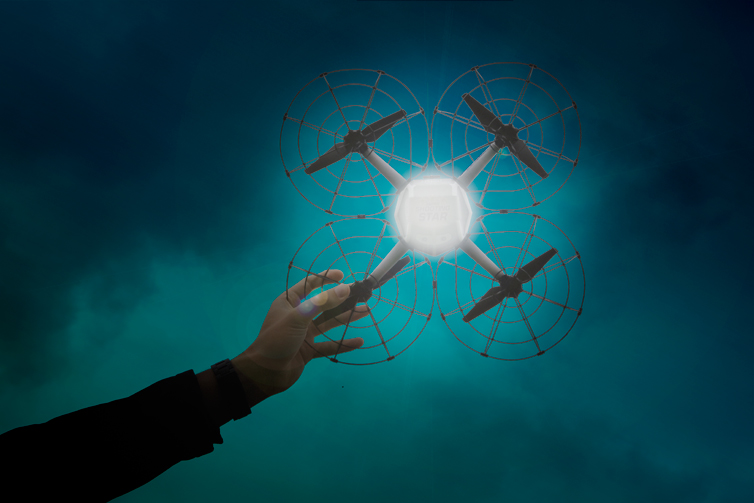Less than a year after setting the Guinness World Records title for 100 drones flying simultaneously, Intel engineers set a new world record with a fleet of 500 drones specifically designed for light shows.
The fall-colored sunset darkened above Krailling, Germany as thousands of tiny propellers began spinning in unison in a field. The steady hum of 500 drones, each fitted with an LED light, peaked as they instantaneously lifted into the air and danced together across the sky like synchronized fireflies. The fleet formed 3D shapes, spelled out recognizable words and painted the number 500 in the air.
Brought to life by 500 Intel Shooting Star drones controlled by one pilot using a laptop, the choreographed lightshow set a Guinness World Records title on October 7, 2016 for the Most Unmanned Aerial Vehicles (UAVs) airborne simultaneously.
A fleet of drones could be used to meet industrial needs and search and rescue missions.
From 100 to 500 Drones
The UAV light show system was designed by Intel and has FAA approval to fly in the USA.
Cheung was with the Intel team when it first set a Guinness World Records title in late 2015 with a 100 drone light show outside of Hamburg, Germany. A few months later, Intel demonstrated drone system in Palm Springs, California, showing that U.S. regulatory barriers would allow for such flights.
The first public performance – and the first time over water – of Drone 100 occurred during the summer 2016 Vivid Sydney event in Australia, accompanied live by the Sydney Youth Orchestra.
“Drone 100 was amazing, but having 500 drones in the same amount of airspace flying much closer together is breathtaking,” said Cheung.
Daniel Gurdan, the engineering lead for Intel Shooting Star drones said 500 feels an order of magnitude bigger than 100 UAVs.
“You totally lose the sense for how many are actually in the air,” he said.
Gurdan had the idea to take Drone 100 to a new level by improving and simplifying the system. This led the team to make the Intel Shooting Star drone, a lightweight, safe and durable drone designed specifically for light shows.
“Optimized is the best word to describe Intel Shooting Star drones,” said Cheung. “When designing them, our team thought about everything from the manufacturing process, efficiencies with operating, and safety aspects to the operator and audience perspectives.”
Optimized Hardware and Software
Previous drones used for Drone 100 weighed more than two pounds. Instead, new Shooting Star drones only weigh 280 grams. They have a tightly integrated LED payload built into a soft frame made of frangible materials such as flexible plastics and foam. Propellers are protected by covered cages. There are no screws.
Flight height is limited by legal limitations, which usually means no more than 400 feet above ground in the U.S. Gurdan explained Shooting Star drones fly automatically and can maintain stability in wind speeds of up to 33 feet per second. They’re even splash-proof so they can fly in light rain.
“The flight controller is highly precise, very robust in gusty conditions and has proven reliability,” Gurdan said. Similar control software also powers the Intel Falcon 8+ commercial drone and Volocopter, the first certified multicopter to fly with a person onboard.
Earlier Drone 100 light shows took five months to build and required more than 15 people to manage the event. It required setting up an airfield and manually resetting, updating and charging the drones before each flight. With the Intel Shooting Star system, the latest optimized light show system can be ready in a few days, and can be managed by a handful of people or just one operator if there’s no need for backup.
The automated system makes the Shooting Star fleet easy to update and operate. The system checks each drone before flights then selects the most optimized drones based on the fullest battery, good GPS reception and other factors, according to Gurdan.
“Sophisticated algorithms optimize distances during launch and landing to avoid collisions,” he said. “And the vehicles remain protected because of the propeller cages.”
Chueng describes them as precisely programmed, extremely responsive machines doing something that is impossible to replicate by hundreds of human pilots flying hundreds of drones.
Optimized Animation
To create earlier animations for Drone 100, programmers had to map the path for each drone. Now the system can take almost any picture – like the Intel logo, for example — and software automatically determines the fastest flight path for a given number of drones.

“We run through a simulation on a laptop, see how it works, and then load it onto the drones with a click of a button,” said Cheung.
The new hardware and software allow more drones to fly and closer together.
“Instead of having a 20-foot distance between drones in the air, we can actually get as close as 5 feet,” said Cheung. “When drones can be closer to each other, it creates a brighter and more beautiful image.”
“The FAA approved Intel Shooting Star drones after reviewing the systems’ protocols and safety implementation guidelines,” said Cheung.
Drone 500 has a Part 107 Waiver to fly in the U.S. in class G airspace, which could help gain approval for flying in other countries.
“We’re showing regulators around the world that UAV technologies used the right ways can help shape new rules for manned and unmanned aerial vehicles,” said Cheung.
























